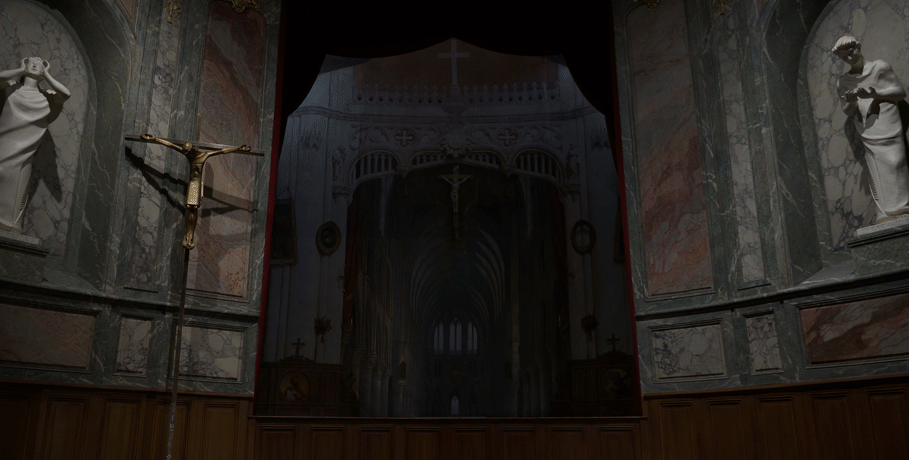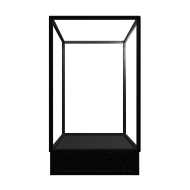The last remaining original Daguerre/Bouton diorama, donated by Daguerre to the church of Bry-sur-Marne (near Paris) in 1842. The diorama was restored in 2013, with funding by the Getty Foundation.
Visited October 2019.

The diorama.
Louis Daguerre (1787 – 1851) was trained as an architect and panorama painter, and first gained attention for his use of illusionist effects in his theatre stage designs, before moving on to, together with painter Charles-Marie Bouton (1781 – 1853), develop the first incarnation of the Diorama (giving it its name), and, later on his signature photographic technique.
In 1842, Daguerre – either with or without help of Bouton – turned the otherwise unremarkable little church of the suburban Paris village Bry-sur-Marne into a megalomanic gothic cathedral. An extension to the choir was built, and a monumental semi-opaque painting replaced the old backside of the church.
The painting is lit by a skylight above the alcove, and additional light effects in the front and the back of the painting simulate a day/night sequence. Originally, the painting was lit with oil lamps. These are now replaced with much safer lighting.

My visit took place during a sunny afternoon. For some reason the church has glass doors, and the reflection of the sun on passing cars at first spoiled the experience. Only after the doors were closed, the sequence could be seen better, though it still seemed to have some problems: one of the lights promptly turned on and off, instead of gradually – I doubt it was meant to do that.
The sequence’s length was unclear to me: it could be just below 2 minutes, but it also could be longer, or even random.
The ‘show’ is started by pressing a button – much like a regular light switch – near the entrance. The first ten seconds or so nothing seems to happen, and some of the light transitions are so subtle they’re difficult to make out, though this could also be due to the sunny afternoon conditions outside.
Still, it’s not hard to imagine the magical impression this piece of religious high-tech theatre must have made on the church-goers.
The faux-marble (painted on the walls) neo-Renaissance side panels, including its statues, are part of the stage. Before the restoration in 2013, barely any of the illusionary depth and simulated grandeur of the wall and choir was left.
Below an 1852 illustration of the diorama, and an early 20th century postcard in honor of Daguerre. By this time, Bouton was completely overshadowed by this partner’s marketing success, both in dioramas and in photography.


Throughout the decades, and even centuries, the illusionist effect of the diorama diminished. Below, a photo taken around 1950. The marbled walls have no paint left or were painted over, and the altar is taking up half of the actual diorama.

At the second Vatican Council of 1962 the Catholic church decided to modernize, leading to the destruction of countless historical altars and church interiors (in Dutch referred to as ‘the second Iconoclasm’, or ‘wreckovation’).
The alcoves on both sides would be fitted with glass stained windows, the gothic elements – including the pulpit – removed, and the seating updated.
The Tourist Service of Bry-sur-Marne was so kind to provide me with a pdf – originally a Powerpoint presentation – concerning the restoration of the diorama. It includes some pre-restoration pictures of the church.
A portable Diorama
Below: the front- and backside of a recently rediscovered diorama-painting by Daguerre and Charles-Marie Bouton. The painting is only 92 x 152cm and framed, and therefor lacks the real immersive experience of the life sized illusion of the Bry-sur-Marne installment.

When the Parisian Galerie Perrin bought this atmospheric painting of the Pisa Cathedral, they knew there was something unusual about it. “There’s a small hole in the canvas,” Mandy Tutin told artnet News. “We thought, ‘this is not normal, this isn’t an accidental hole.’”
After careful research, they realized they had stumbled upon a Louis Daguerre (1787–1851) diorama, a unique form of painting devised by the artist and inventor in 1822, nearly two decades before he invented the daguerreotype. Working with painter Charles Marie Bouton (1781–1853), he crafted canvases with elements painted on both sides, so that the work shifts in appearance under different lighting conditions. He showed works such as this one in his custom-built Paris venue, called Diorama.
“People went as if it were the cinema,” Tutin said. “It’s like a little movie.”
Nearly two centuries later, the effect is still stunning, as the scene miraculously shifts from day to night, with a figure holding a torch appearing in the center of the canvas, the flame aligned with the once-mysterious hole. The effect, explained Tutin, “is a reflection between the light and the transparency of the canvas.”
The piece is for sale for €850,000. “This is unique in the world, the very last one in private hands,” Tutin added.
Hippolyte Sébron
Daguerre, though by far the most famous diorama-producer – was not the best painter. He was considered more of an inventor. His partner Bouton was widely appreciated for his much more sophisticated paintings.
Sébron (1801 – 1879) was Daguerre’s ‘right hand’. After Daguerre got interested in photography, Sébron took over most of the painting, though he remains out of the spotlights. Sébron perfected the double-effect diorama: canvasses that would would show hidden elements when lit in certain ways. These canvasses temporarily saved the diorama business from bankruptcy, since the crowd would grow tired of the standard diorama-formula: a landscape (Swiss Alps, for instance), followed by an interior (a church or cathedral).
Sébron claims to have painted fourteen monumental illusionist diorama paintings.
Source: Erkki Huhtamo, ‘Illusions in Motion’, MIT press, 2013, p. 147-148.

